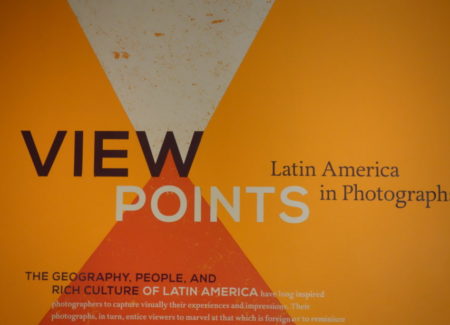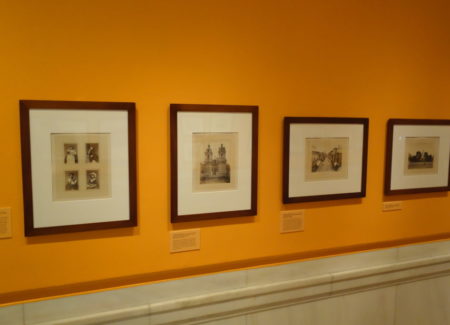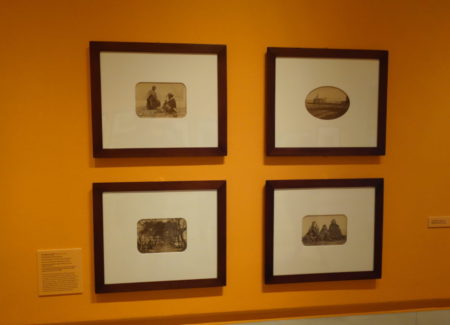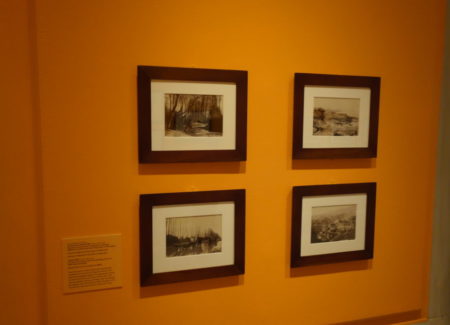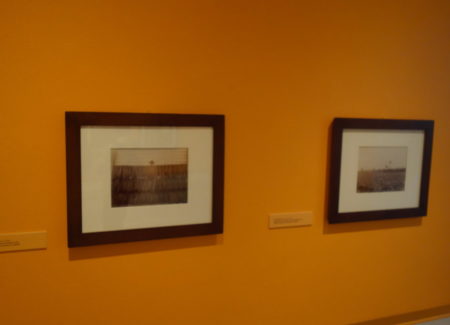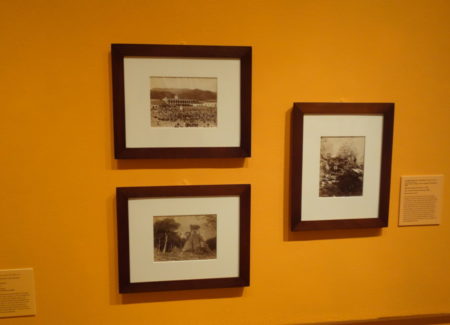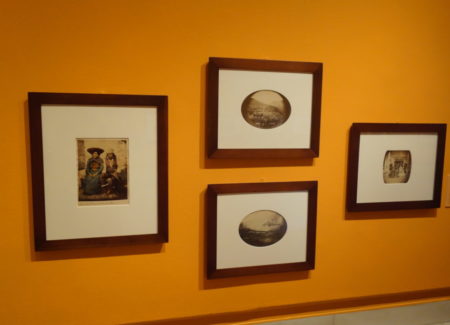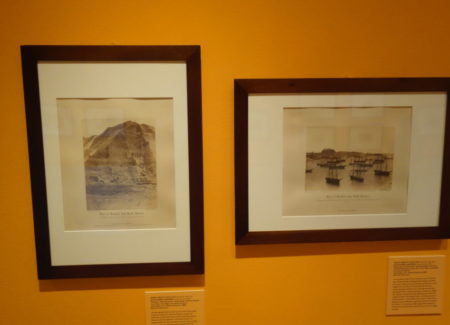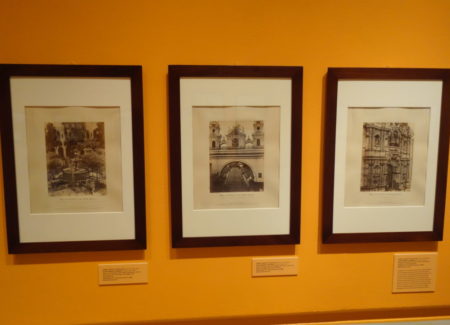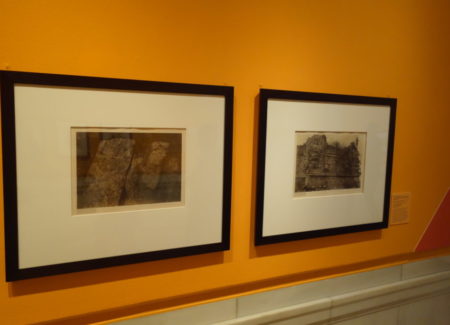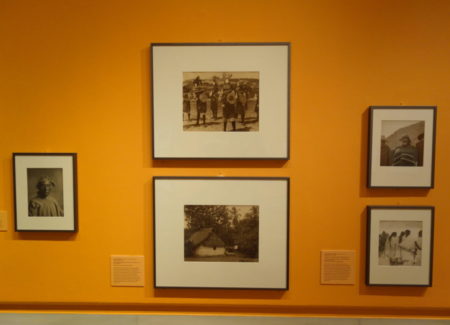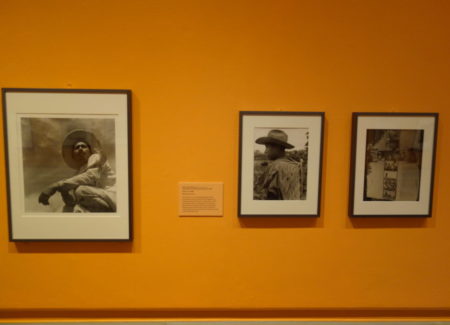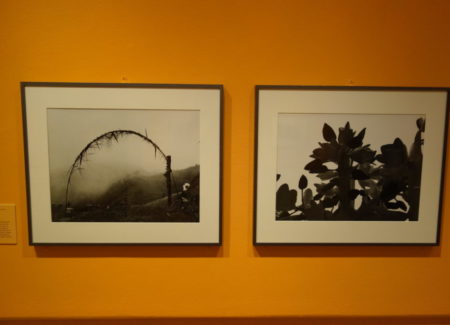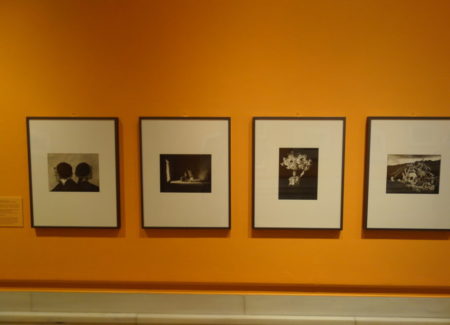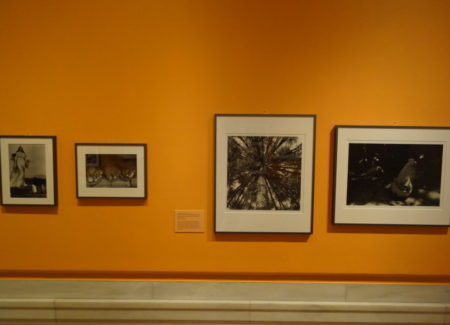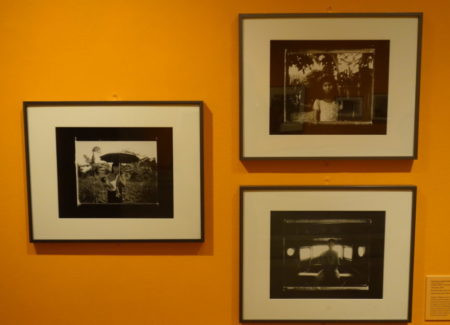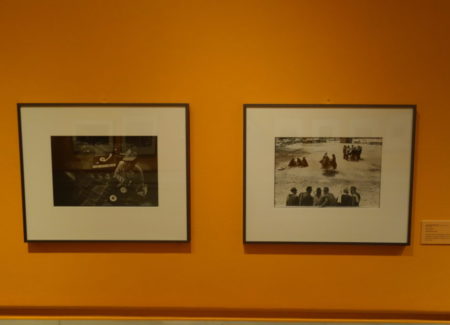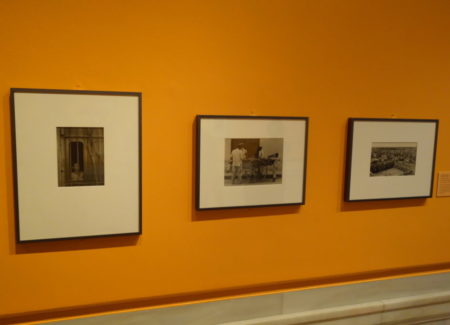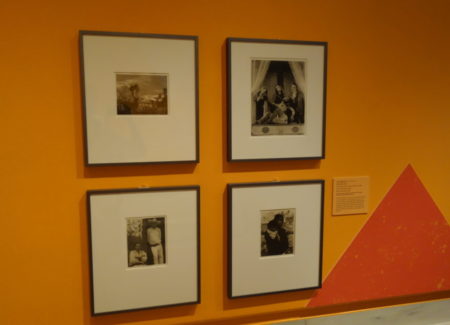JTF (just the facts): A group show containing 117 black and white and color photographic works from 41 different artists/photographers, variously framed and matted, and hung against orange walls in two separate galleries on the second floor of the library. The show was organized by Elizabeth Cronin, Assistant Curator of Photography. All of the works were drawn from the library’s permanent collection.
The following artists/photographers were included in the exhibit, with the number of works on view, their dates and their processes as background:
- Jules Jullia: 1 salted paper print, 1855
- Witcomb & MacKern: 1 albumen silver print panorama, 1879
- Courret Hermanos: 4 albumen silver prints c1860, c1863, c1868
- Esteban Gonnet: 4 albumen silver prints, c1866
- Anonymous: 2 albumen silver prints, 1870s
- Abel Briquet: 4 albumen silver prints, 1880s-1890s
- Hans Frey (and attributed to Hans Frey): 4 gelatin silver prints, printed out, 1890s
- G. Blain: 2 gelatin silver prints, printed out, 1900s
- Claude-Joseph Désiré Charnay: 2 albumen silver prints 1862-1863
- Louis Édouard Roussel: 4 albumen prints from paper negatives, 1863, 1864
- Henry DeWitt Mouton/Alexander Gardner: 5 albumen silver prints, 1865
- John W. Nyerson: 4 albumen silver prints, some hand colored, c1868
- Alfred Percival Maudslay: 3 albumen silver prints, 1881, 1882, 1894
- Mayo & Weed: 4 gelatin silver prints, printed out, 1898
- Dana B. Merrill: 20 gelatin silver prints, 1909-1912
- Manuel Mancilla: 1 gelatin silver print 1920s-1930s
- Hugo Brehme: 2 gelatin silver prints, sepia toned, 1930s
- Julio de la Fuente: 2 gelatin silver prints, ferrotyped, 1938
- Manuel Álvarez Bravo: 1 platinum print, 1949
- Martin Chambi: 4 gelatin silver prints/postcards, 1924, 1932, 1935, 1938
- Leo Matiz: 1 gelatin silver print, 1941
- Hector Garcia: 2 gelatin silver prints, 1965, 1980
- Graciela Iturbide: 2 gelatin silver prints, 1980, 1982
- Mariana Yampolsky: 2 gelatin silver prints, n.d.
- Daniel Chauche: 3 gelatin silver prints 1989, 1993/2014
-
Flor Garduño: 4 platinum palladium prints, 1988, 1989, 1990
- Sebastião Salgado: 2 gelatin silver prints 1980, 1983
- Valdir Cruz: 2 gelatin silver prints, 1991, 1997
- Sze Tsung Nicolas Leong: 3 chromogenic color prints, 2006, 2010
- Luis González Palma: 1 hand painted photograph on watercolor paper, 1993/2011
- Paul Strand: 4 photogravures, 1933/1967
- Walker Evans: 2 gelatin silver prints, 1933
- Margaret Bourke-White: 2 gelatin silver prints, 1936
- John Vachon: 1 gelatin silver print, 1944
- John Collier, Jr.: 1 gelatin silver print, 1959/later
- Ann Parker: 2 silver dye bleach prints, 1970s/1985-1986, 1 gelatin silver print, 1970s
- Edward Grazda: 2 gelatin silver prints, 1975, 1977
- Douglas Sandhage: 3 gelatin silver prints, 1974
- Edward Ranney: 3 gelatin silver prints, 1985, 1994, 2004
(Installation shots below.)
Comments/Context: Whether we generally acknowledge it or not, the physical architecture of a museum or gallery plays a surprisingly important role in exhibition design. Broad open spaces with movable white walls allow for maximum flexibility (and creativity), while display areas in stately homes and mansions are often limited by the style of the rooms and the nearby furnishings, forcing curators into different kinds of problem solving.
The second floor galleries at the New York Public Library are closer to this second example than the first. Two long narrow corridors flank the open central area, and displays of photography are often shown in linear one-by-one fashion, winding up one side and down the next, before moving across the way and repeating the same process. But this survey show of Latin American photography uses these transitional galleries in an inspired fashion, making their hallway architecture an integral part of the conception of the show.
Assistant curator Elizabeth Cronin’s key insight is that Latin American photography (all the way from northern Mexico to southern Argentina and Chile) can be historically divided between the images made by residents and natives (including émigrés from Europe and elsewhere) and those made by visitors, tourists, colonial/government agents, and other travelers. Using a chronological progression, she has organized the works of the two groups on opposing walls, creating a back-and-forth dialogue between insider and outsider and allowing us to see the choices each made in their attempts to capture the nuances of the various cities and geographies. In this case, the narrow hallways function as a perfect venue for this smart interplay, as the visitor can stand in the middle and look back and forth, easily comparing the two approaches.
In the 19th century, the differences between the photographs made by locals and foreigners weren’t particularly pronounced, as the impetus for the pictures was largely similar. Aside from the cartes-de-visite portraits from the Peruvian studio of Courret Hermanos, the images on view were primarily made for an audience outside Latin America. Local photographers made sweeping panorama views of Buenos Aires and Valparaiso, documented the progress of the Mexican National Railway, and captured genre portraits/scenes of Patagonian Indians, Argentine gauchos, and Cuban tobacco pickers.
Visiting image makers headed for similar subjects, perhaps with a more single minded, project-style focus that often manifested itself as albums, atlases, or systematic surveys. Architectural views not unlike those made in Europe on the Grand Tour showed us Yucatan ruins (including carved stone details), church facades in Lima, and the rubble strewn aftermath of the siege of Puebla in Mexico. And snippets from daily life were used to promote travel, education, and investment, from Mayo & Weed’s fighting cocks and Mexican waterfalls to Dana B. Merrill’s ant nests, oversized beetles, and landslides from a Brazilian railway project.
When the show turns its attention to the 20th century, the aesthetic separation between the locals and the foreigners becomes more noticeable. Paul Strand, Walker Evans, and Margaret Bourke-White all visited Latin America in the 1930s (making pictures in Mexico, Cuba, and Brazil respectively), but their crisply seen portraits and details from everyday life continued to have the distance of outsiders – religious icons, fruit carts, and coffee pickers were novel subject matter, still surfaces rather than engaged cultural subtleties. And while Edward Ranney’s elevated geoglyph landscapes were made recently, they recall the documentary impulses of the 19th century surveyors, the artist’s effort to capture the faint lines in the desert for posterity not unlike that of those who systematically categorized other ancient ruins a century earlier.
It is the deliberate attention paid to cultural customs, local folklore, peasant life, and indigenous populations, and the conscious effort made to bring a more poetic and allegorical approach to image making that gives the 20th century work of the native artists its defining character. Hugo Brehme showed us regional dances, Hector Garcia gave us a peasant with a large leaf on his back, Leo Matiz honored the labor of a machete worker, and Sebastião Salgado found beauty in weathered toes and worn sandals – details that only a local would think to photograph. Martin Chambi’s images from Peru encompassed formal studio portraits of Cusco families as well as pictures of carnival celebrations and peasants tending llamas. And Graciela Iturbide’s cluster of chickens, Flor Garduño’s floral basket and swirling skulls, and Luis González Palma’s boy with wings on his ears pushed the storytelling further, embracing the edge of the surreal and the magical.
The strength of this exhibit lies in its sampler approach, its well-edited choices allowing viewers to see the changes from one historical style to another over time and to discern the differences between the insider/outsider viewpoints. While the show runs out of gas as it reaches the 21st century (as we might expect given the nature of institutional collecting), there is plenty of thoughtful context here that is worth absorbing. Most importantly, the exhibit reinforces the idea that as the local photographers gained confidence, they opened up sophisticated new understandings of life in Latin America. While the insider/outsider dichotomy will continue to inform contemporary work from the region, it’s clear that much of the photographic innovation going forward will be coming from voices embedded deep within the fabric of the various local communities. That conclusion is exciting, as it leads us to expect photographic insights from those who are best placed to observe something new.
Collector’s POV: Since this is a museum show, there are of course no posted prices. And given the diverse nature of the works on view, we will dispense the usual discussion of gallery representation and secondary market histories.
